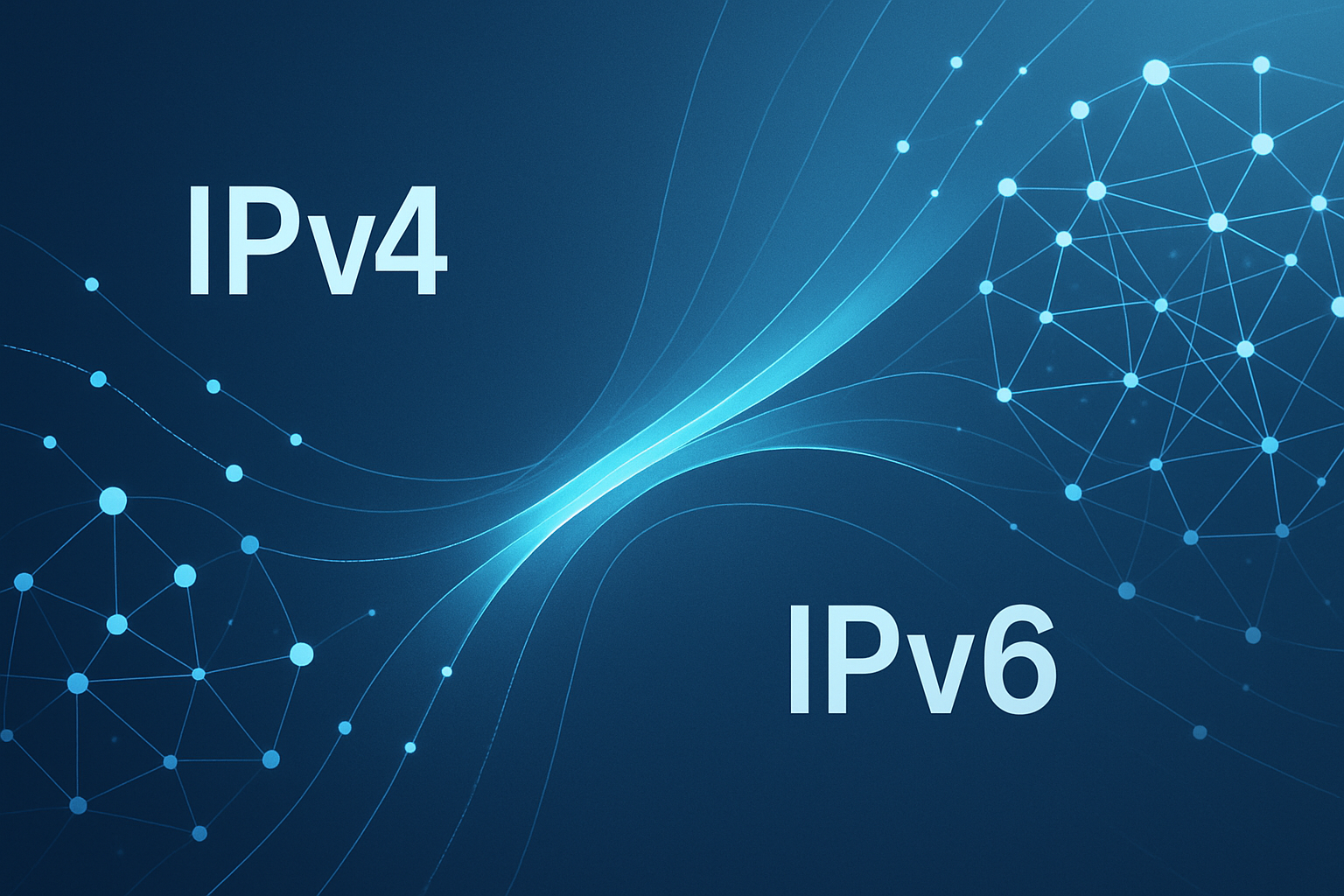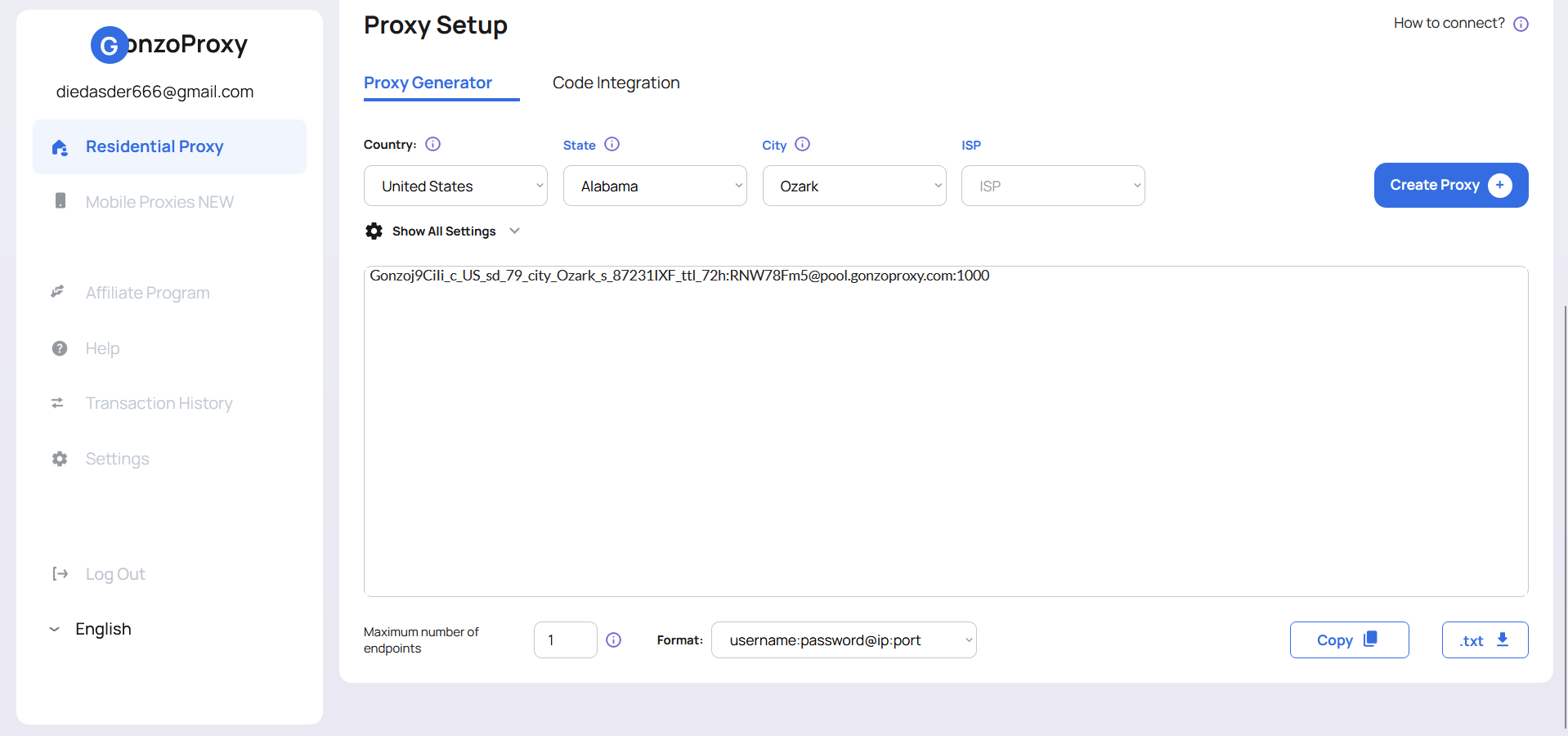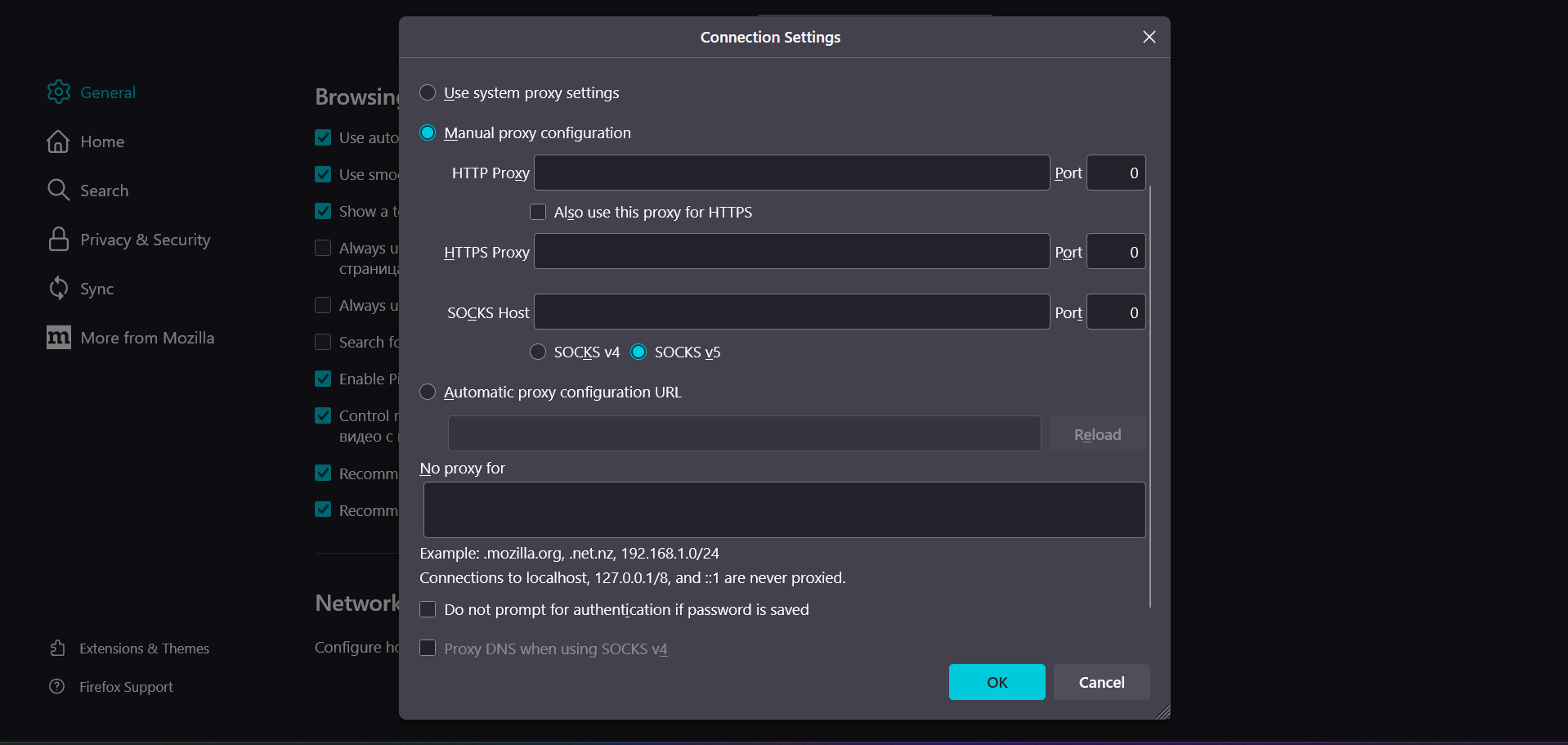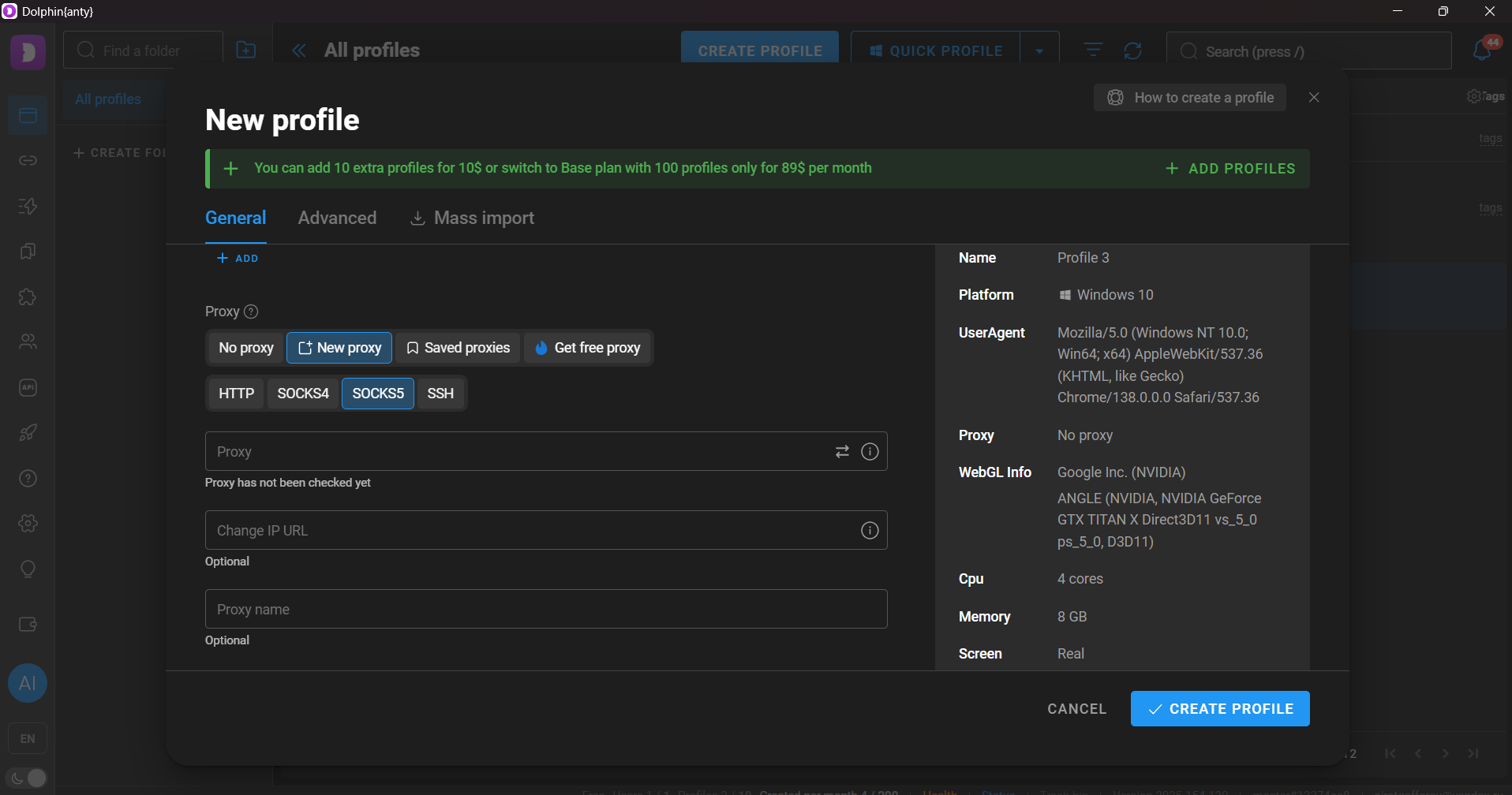Buying proxies becomes a real quest when the manager asks about IPv4 or IPv6. Most clients get confused. Some pick IPv4 because it sounds familiar. Others think logically: six is bigger than four, so the technology must be newer. Both approaches lead to a dead end.
IP protocols are the rules by which devices exchange data on the internet. Each device gets assigned a unique address, like a phone number in the global network. Proxy servers act as intermediaries: they hide your real IP by substituting their own. You need them to bypass blocks, maintain anonymity, access geo-restricted content, and scrape data without getting banned. Choosing between IPv4 and IPv6 determines what type of address your traffic gets — and this is critical.
IPv4 addresses are running out. Literally. Less than one percent of free blocks remain. Corporations are buying up the rest at astronomical prices — individual ranges go for millions of dollars. Meanwhile, IPv6 offers so many addresses that there'd be enough to give billions to every grain of sand on a beach. The paradox: there's plenty of space, but half the internet doesn't look there.
Understanding the difference between protocols is critically important. Choose the wrong proxy type — lose money or time. IPv4 works everywhere but costs a fortune and often lands on blocklists. IPv6 is cheap and clean, but many sites ignore it. This is especially critical for those who parse large datasets, set up anti-detect systems, or automate routine processes.
Contents
- VPN and Proxy: Key Differences
- What is a Proxy Server?
- What is VPN?
- Security and Privacy
- Speed and Performance
- When Should You Use a Proxy Server?
- When Should You Use VPN?
- Is It Worth Using VPN and Proxy Together?
- Mistakes When Choosing Between VPN and Proxy
- Busting Myths About VPN and Proxy
- VPN or Proxy: How to Choose the Right Option?
- FAQ
- Conclusion
- What is a proxy server for Google Chrome and why do you need it
- How proxy works in Chrome browser
- Ways to configure proxy in Google Chrome
- Setting up proxy in Google Chrome through Windows
- Setting up proxy in Google Chrome through macOS
- Setting up proxy for Chrome through extensions
- Setting up proxy in Chrome on Android
- Setting up proxy in Chrome on iPhone and iPad
- Connection check and speed test
- Typical errors when working with proxy in Chrome
- FAQ
- Conclusion
- Why you need proxies for Reddit
- Why Reddit might be blocked
- What restrictions does Reddit have
- Who needs proxies and how they help
- What you can do with proxies for Reddit
- How to choose the right type of proxy for Reddit
- Proxy vs VPN for Reddit
- How to set up and use proxies for Reddit
- Top proxy providers for Reddit in 2025
- Common problems and solutions
- Practical use case scenarios
- FAQ
- Conclusion
- Why LinkedIn requires using proxies
- How proxies help in working with LinkedIn tools
- Types of proxies for LinkedIn and selection criteria
- 10 best proxy providers for LinkedIn
- Setting up and using proxies
- Tips for safe LinkedIn outreach scaling
- FAQ
- Conclusion: how to build a stable system for working with LinkedIn through proxies
- How Amazon detects and blocks proxies
- Benefits of using proxies for Amazon
- Which proxy types work best for Amazon
- Best residential proxy providers for Amazon (2025)
- Key features of a good Amazon proxy provider
- How to set up a proxy for Amazon
- Common problems when working with proxies on Amazon
- How to use Amazon proxies for different tasks
- Best practices for safe Amazon proxy usage
- FAQ
- Conclusion – choose stability, not quantity
- Step 1 — Download and Install VMLogin
- Step 2 — Create a New Browser Profile
- Step 3 — Get Your Gonzo Proxy Credentials
- Step 4 — Configure Proxy Settings in VMLogin
- Step 5 — Verify Proxy Connection
- Step 6 — Launch Your Browser Profile
- Step 7 — Optional: Set Up Multiple Profiles / Rotating Sessions
- Step 8 — Troubleshooting Common Issues
- Step 9 — Start Automating with Gonzo Proxy + VMLogin
- What is an anonymizer in simple terms
- How anonymizers differ from proxies and VPNs
- How an anonymizer works
- Types of anonymizers and anonymity levels
- How to format proxies for working with anonymizers
- How to use an anonymizer to access blocked sites
- Advantages and risks of using anonymizers
- How to choose an anonymizer or proxy for your tasks
- FAQ
- Conclusion
- How to sell quickly and effectively on Avito
- What is mass posting on Avito and why you need it
- Manual and automated mass posting
- Multi-accounting: how to manage multiple accounts on Avito
- Step-by-step launch plan
- How not to get banned with mass posting and multi-accounting
- Mass posting vs alternative sales methods
- FAQ
- Conclusion
- What Is a Proxy for Discord?
- Why You Should Use Proxies on Discord
- How to Use a Proxy on Discord
- Testing and Monitoring Proxy Performance
- Scenarios Where Discord Proxies Help
- Best Practices and Safety Tips
- Why Choose Residential Proxies for Discor
- Common Problems and Troubleshooting
- FAQ
- Final Thoughts — Keep Your Discord Setup Secure and Efficient
- Why TikTok gets blocked and doesn't always work with VPN
- How proxies and VPN differ for TikTok
- When it's better to choose VPN for TikTok
- When it's better to choose proxy for TikTok
- How to set up proxy for TikTok (short instruction)
- Risks and precautions when working with TikTok through VPN and proxies
- FAQ
- Conclusion
- What does transparent proxy mean
- How transparent proxy works in a real network
- Spheres of application for "invisible" proxy
- Advantages and disadvantages of transparent proxy
- Setting up transparent proxy: step by step
- Are transparent proxies secure
- Popular solutions for transparent proxy setup
- Checklist for working with transparent proxies
- FAQ
- Conclusion
- Why proxies are a must for Dolphin Anty
- Types of proxies you can connect to Dolphin
- Rotating vs Static
- Step-by-Step: How to Add a Proxy in Dolphin Anty
- Common proxy connection errors and fixes
- How to choose reliable proxies for Dolphin Anty
- Tips for optimizing costs
- Practical cases of using Dolphin Anty with proxies
- FAQ
- Final thoughts
- Types of proxies used for parsing
- How to choose proxies for parsing
- Setting up and rotating proxies for parsing
- Technical tricks for bypassing blocks
- Practice: building a proxy pool for parsing
- Metrics and monitoring parsing quality
- Best practices and ready solutions
- FAQ
- Summary: Which proxy to choose for parsing
- How proxies work in traffic arbitrage
- Types of proxies for arbitrage and their features
- What problems do proxies solve in arbitrage
- Top proxy providers for arbitrage in 2025
- Comparison table of proxy providers
- How to pick the right proxies for arbitrage
- How to set up proxies for arbitrage
- Safe proxy usage tips
- FAQ
- Conclusion
- What are residential proxies needed for?
- How do residential proxies work?
- How do residential proxies differ from others?
- Connecting residential proxies from GonzoProxy
- Examples of using GonzoProxy residential proxies in Python
- Pros and cons of residential proxies
- How to check residential proxies
- Common usage errors
- FAQ
- Conclusion
- Why does Facebook often block accounts and cards?
- Why use a virtual card for Facebook Ads?
- Multicards.io — a trusted virtual card service for Meta Ads
- Should you buy or create Facebook ad accounts?
- Why proxies are essential
- What kind of proxies are best for Facebook Ads?
- GonzoProxy — premium residential proxies for Facebook Ads
- How to safely link a virtual card to Facebook Ads
- Final recommendations
- What’s a DePIN farm and why should you care?
- So, what exactly is DePIN?
- Other DePIN projects already killing it
- What do you need to start your DePIN farm?
- How to create profiles and set up the antidetect browser
- How to choose and set up a proxy?
- What about Twitter/X accounts?
- How to get email accounts?
- Before you launch — one last tip!
- How to properly chain your accounts?
- How modern fraud detection systems track violators
- Google Ads: anti-fraud specifics in 2025
- How to tell your proxies aren't working?
- Why most proxies no longer work with ad platforms
- How to select and verify proxies for ad platforms
- Strategy for stable operation with ad platforms
- Conclusion: don't skimp on infrastructure
Any device on the network gets a unique number — an IP address. Without it, data simply can't find its way. Imagine a huge warehouse with billions of cells. Each package (data packet) carries a tag with the recipient's cell number. No number — no delivery.
The IPv4 and IPv6 protocols determine the format of these numbers. The old system uses short addresses. The new one uses long addresses. Seems like a small thing. But this small thing revolutionizes network operation principles, affects security, speed, and even service costs.
Proxy servers work as intermediaries — they substitute your real IP address with theirs. Choose IPv4 proxies — get the old address format that all sites understand, but costs a lot and often ends up on blacklists. Take IPv6 — save money, get fresh addresses, but risk running into a site that simply won't see your traffic. The choice of proxy protocol directly determines the success of your tasks: whether registration will go through, information will be collected, or accounts will get blocked.
IPv4 was born in an era when computers filled entire rooms. Back then it seemed: four billion addresses would last forever. The format is simple — four numbers separated by dots: 192.168.1.1 or 77.88.8.8. Easy to remember, simple to configure.
Problems started in the nineties. The internet exploded into the masses. First computers in offices. Then home PCs. Followed by smartphones, tablets, TVs, refrigerators, light bulbs. Everything demands its own address.
They invented a workaround — NAT technology. The router gets one external address and internally distributes private addresses to dozens of devices. It works, but it's slow. Every packet goes through address translation. Direct connections between devices become a headache. Online games require port forwarding. Video calls glitch. Torrents download slower.
Real case: a company launches a network of 500 retail locations. Each needs a static IP to connect to the central database. Buying 500 IPv4 addresses will cost $25-30 thousand annually. A NAT and VPN solution is cheaper, but complicates problem diagnosis and slows data synchronization by 20-30%. Another example — gamers. Popular games like Call of Duty or FIFA use P2P connections. Two players behind NAT can't connect directly without a STUN server. Result — lag, connection drops, voice chat problems.
What IPv6 means and why it was introduced
IPv6 was created with a margin. They took and increased the address length by four times. The result is a monster like 2001:0db8:85a3:0000:0000:8a2e:0370:7334. Eight blocks of hexadecimal numbers. Looks scary, but there are enough addresses to last until the end of time.
340 undecillion unique combinations. A number so huge that the brain refuses to comprehend it. Try to imagine: every atom in your body could get a million addresses, and there'd still be leftovers.
NAT becomes unnecessary. Every light bulb gets a global address. Direct connections work without dancing with tambourines. Security is built into the protocol, not bolted on from the side. Routing is simplified, packets fly faster.
But there's a catch. Old equipment doesn't understand new addresses. Sites aren't rushing to update. Providers save money on modernization. The result is curious: the technology of the future exists, but you can only use it half the time.
The difference between protocols goes deeper than address length. The logic of network operation changes, routing principles, security mechanisms.
Address format and address space volume
IPv4 operates with 32 bits. Four octets of 8 bits each. Maximum 256 values in each octet. Simple math gives 4,294,967,296 addresses. Subtract service ranges, private networks, multicast. About 3.7 billion working addresses remain.
IPv6 expands the address to 128 bits. Eight groups of 16 bits each. Each group is written with four hexadecimal symbols. Result: 340,282,366,920,938,463,463,374,607,431,768,211,456 combinations. Hard even to pronounce.
To understand the scale: if you handed out a million IPv6 addresses every nanosecond, the supply would be exhausted in 10 trillion years. The sun will burn out sooner.
Device support and NAT operation
NAT in the IPv4 world is a forced measure. Billions of devices hide behind hundreds of millions of public addresses. The router remembers which internal device sent a request and redirects the response back.
The scheme breaks with incoming connections. An external server can't see devices behind NAT directly. You have to configure port forwarding, use STUN servers, struggle with UPnP. Each additional layer means speed loss and increased delays.
IPv6 removes intermediaries. A device gets a global address and communicates with the world directly. The firewall controls access but doesn't translate addresses. Problem diagnosis is simplified — you see the real traffic source, not the router's address.
Speed, security, and scalability

Theory is great, but you're interested in practice. Which proxies to take for specific tasks? Where to save money, and where it's better not to risk?
What's better — IPv4 or IPv6 proxies
Marketers and SEO specialists are stuck in IPv4. Search engines index sites through the old protocol. Ad networks check traffic quality by IPv4 addresses. Analytics systems are tuned for version four. Take IPv6 for promotion — get problems.
Parsing and scraping is a different story. Sites block IPv4 proxies in batches. One address gets burned — the entire range goes into the ban. With IPv6 it's easier. Many addresses, cost pennies, rotation isn't a problem. True, not all services offer them. GonzoProxy, for example, specializes in quality IPv4 addresses with smart rotation — parse large data volumes without risk of mass blocks thanks to constant pool updates.
Anti-detect browsers work with both protocols, but there are nuances. Facebook and Google accept IPv6 normally. Instagram and TikTok might suspect something's wrong. Banks and payment systems often don't see IPv6 traffic at all. You have to keep both proxy types and switch as needed.
When IPv6 proxies are more advantageous
Mass registrations are an ideal scenario for IPv6. Need a thousand accounts? Take a thousand addresses. Each account gets a unique IP. Security systems see different users, not a bot farm.
Web scraping large data volumes requires address rotation. With IPv4 you have to buy expensive pools or put up with blocks. IPv6 solves the problem with brute force — there are so many addresses you can change on every request.
Testing geo-dependent content through IPv6 works crookedly. Geolocation databases update slowly. An address might be listed in Germany but physically located in Asia. For accurate geo-targeting, stick with IPv4.
How proxy connection works
Proxy setup scares newbies. In reality, everything's simpler than it seems. Modern services have automated the process to a couple of clicks.
IPv4 proxy connection example
Browser setup takes a minute.
1. Get proxies from GonzoProxy

2. Open browser network setting

3. Enter the received proxy
Gonzoj9CiIi_c_US_sd_79_city_Ozark_s_87231IXF_ttl_72h:RNW78Fm5@pool.gonzoproxy.com:1000, where:
- IP - pool.gonzoproxy.com
- Port - 1000
- Login - Gonzoj9CiIi_c_US_sd_79_city_Ozark_s_87231IXF_ttl_72h
- Password - RNW78Fm5
4. Click OK, done. Now your browser works through proxy
Connection through anti-detect browser: Anti-detect browsers (AdsPower, Multilogin, GoLogin, Dolphin Anty) set up even easier:
1. Create a new profile or edit existing one
2. In "Proxy" section choose "Custom" or "Manual setup"

3. Specify HTTP/SOCKS5 type, enter previously obtained proxies

4. Test connection and save profile
Developers prefer console:
export HTTP_PROXY=http://login:password@185.22.173.94:8080
wget https://example.com
Python scripts are configured through the requests library:
proxies = {
'http': 'http://login:password@185.22.173.94:8080',
'https': 'http://login:password@185.22.173.94:8080'
}
response = requests.get(url, proxies=proxies)
Proxy authorization: When you have login and password, connection format: http://login:password@IP:port. This works in all programs — from browsers to parsers.
IPv6 proxy connection example
IPv6 requires attention to syntax. Square brackets are mandatory, otherwise the program will confuse address separators with port:
curl -x http://[2001:db8:85a3::8a2e:370:7334]:8080 https://example.comBrowser settings are similar to IPv4, but the address is enclosed in brackets: [2001:db8:85a3::8a2e:370:7334]. Many programs require additional flags for forced IPv6 use.
Node.js example:
const agent = new HttpsProxyAgent({
host: '[2001:db8:85a3::8a2e:370:7334]',
port: 8080
});
The main problem with IPv6 proxies is unpredictability. A site might accept IPv6 traffic on the main page but block during authorization. Amazon Web Services supports IPv6, but many services on AWS don't. PayPal sees IPv6, Stripe ignores it. Google is fully ready, Yandex partially.
Typical failures: registration form doesn't submit, captcha doesn't load, payment gateway gives error. Solution — always keep backup IPv4 proxy for critical operations. Some anti-detect browsers automatically switch to IPv4 when problems are detected, but it's better to control the process manually.
Before launching, check compatibility. Spend five minutes on tests — save hours on debugging.
Online Tools and Extensions
Test-ipv6.com runs a battery of tests. Checks connection, DNS, packet size, fallback to IPv4. Result shows system readiness for new protocol work.
Whatismyipaddress.com displays both addresses if they exist. Convenient for checking which protocol a specific connection uses.
IPvFoo browser extension highlights the protocol of each resource on the page. Green icon — IPv6, yellow — IPv4. You immediately see which elements slow the transition to new protocol.
Command line verification
Console utilities give precise information without embellishment.
Basic ping check is the fastest way to know if IPv6 works:
ping -6 google.com # Linux/Mac
ping -6 google.com # Windows
If you get a response — IPv6 works. Timeout means connection problems or ICMP blocking.
The nslookup command shows if a site has IPv6 addresses:
nslookup -type=AAAA example.comAAAA records are IPv6 addresses in DNS. If there are none, the site only works through IPv4.
Curl tests real connection:
curl -6 https://example.com # Force through IPv6
curl -4 https://example.com # Force through IPv4
curl --verbose -6 https://example.com # With detailed diagnostics
Additional tools for deep checking:
host -t AAAA google.com # Alternative to nslookup
traceroute6 example.com # IPv6 route tracing
nc -6 -zv 2001:db8::1 8080 # Port test on IPv6 address
Windows users use PowerShell:
Test-NetConnection -ComputerName example.com -Port 443
Resolve-DnsName example.com -Type AAAA
Browser and DNS verification
Browsers hide connection details, but they can be extracted through developer tools.
Chrome — looking at real connection: Open Developer Tools (F12), Network tab. Refresh the page. Click on any request. In the Headers section find Remote Address. If you see an address with colons (2001:db8::1) — the site delivered the page through IPv6. Dots (192.168.1.1) mean IPv4.
Firefox — detailed picture: Enter about:networking#dns in the address bar. You'll see all DNS records in the browser cache. Next to each domain — a list of IP addresses. Long ones with colons are AAAA records (IPv6), short ones with dots are A records (IPv4).
The DNS connection is critical. The browser first asks the DNS server: "What addresses does example.com have?" DNS responds with a list of A and AAAA records. The browser chooses which to use. Usually IPv6 has priority if it's available.
The problem occurs at three levels:
1. DNS server doesn't know about IPv6. Old or poorly configured DNS servers return only A records. The browser physically can't connect via IPv6, even if the site supports it.
2. Site doesn't have AAAA records. DNS honestly searches, but there simply are no IPv6 addresses in the domain zone. The site owner hasn't configured new protocol support.
3. Browser ignores IPv6. Even getting AAAA records, the browser might choose IPv4 due to system settings, routing problems, or connection timeouts.
You can check the entire chain with a simple test. Open https://ipv6-test.com — the site will show which protocol you connected through. Then in the browser console (F12 → Console) execute:
fetch('https://api64.ipify.org?format=json').then(r => r.json()).then(data => console.log('IPv6:', data.ip || 'Not supported'));
fetch('https://api.ipify.org?format=json').then(r => r.json()).then(data => console.log('IPv4:', data.ip));
If IPv6 returns an address — the entire chain works. If error — there's a problem somewhere between your browser and the site. Most often the culprits are provider DNS servers that don't handle AAAA records.
FAQ
There's no clear winner. IPv4 guarantees compatibility but gets more expensive every day. IPv6 opens possibilities for scaling but doesn't work everywhere.
A reasonable strategy is to keep both proxy types. IPv4 for critically important operations: payments, bank authorization, work with conservative services. IPv6 for volume tasks: parsing terabytes of data, creating thousands of accounts, bypassing rate-limiting.
GonzoProxy focuses on providing premium IPv4 proxies with intelligent rotation and high availability. The system analyzes the target resource and selects optimal connection settings. You get reliable IPv4 addresses that work with all services without exception. Use promo code START15 to get 15% discount on your first purchase at GonzoProxy — test proxy quality on your tasks.








